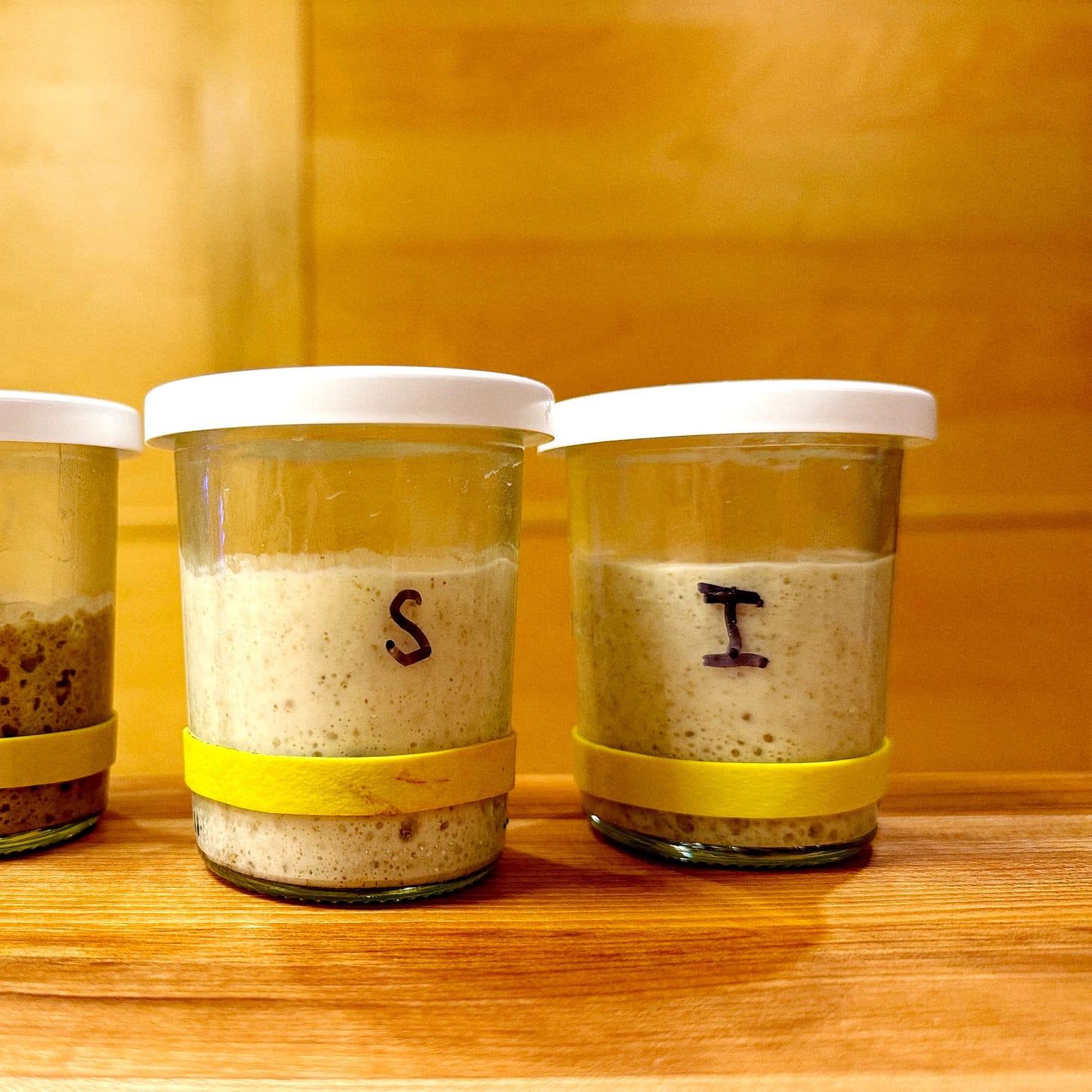Continuous Sourdough Starter Maintenance Without Friction (or Wasted Flour)
Why the fridge isn't your starter's best friend

Table of Contents
Since I got deep into the weeds working on the sourdough formulas for my book, I have been maintaining three separate starters: my trusty “original” one, a rye starter that was given to me by a friend, and another one I started from a dried packet of starter that I’d purchased at least ten years ago and found in the back of my fridge recently. I never expected the last one to revive, but revive it did, and it quickly became as robust as the one I’d had going for years. (The miracles of sourdough microorganisms will never cease to amaze me.)
Since I ramped up to baking with my starters at least a few times a week, I’ve also begun maintaining them at room temperature day-in, day-out. The person who sent me the rye starter said it had never been refrigerated, and I wanted to honor that, so I have been keeping it at room temperature too (the friend said he does dehydrate it when he needs to step away from it for any reason). And seeing as I was already feeding the rye starter at least once a day, it was easy enough to do the same thing with the other two.
It took a month or so, but I eventually noticed that all of my starters began performing far better than when I’d stored them in the fridge in between uses. The breads were great (and more reliably so), but the biggest boost was in consistency—both in how the starter expanded post-refreshment, and in how doughs made with them behaved. Before making the switch to full-time “continuous” starter maintenance, sometimes the bulk fermentation of a dough might take four hours on one day and six on another, despite being proofed at the same temperature. The longer I maintained them at room temperature, the livelier my doughs seemed, rising quickly during the bulk fermentation and springing beautifully in the oven, with the same basic timeline from batch to batch.
I definitely don’t think everyone needs to switch to continuous starter maintenance for success with sourdough breads. I refrigerated my starter for years and years and I made plenty of beautiful breads along the way. And maybe when my work on the book is done I'll go back to refrigerating my starter again. (Maybe. Now that I am keeping them at room temperature, I find myself feeling guilty about even thinking about putting them in the fridge.) But my experience has convinced me that it is something a baker might want to try out, just to see how it improves their breads.
Obviously the hurdle to doing this is the extra time, effort, and flour it requires, but I think I have stumbled upon a way to make it as low-lift as possible.
Say you bake once a week and keep your starter in the fridge between bakes. At the very least, you’ll need to give your starter a single feeding before using it in a dough. So the bare minimum number of feedings is once a week. But really you are better off refreshing the starter two or even three times before using it, which amounts to three refreshments per week, over the course of two or three days. At this point, feeding it on a daily basis instead—provided you are using the starter regularly—starts to seem far less daunting.
In a bakery using their starter every day, they’ll be refreshing it at least twice a day, maybe even three times. For a home baker baking only occasionally, that would obviously be a challenge to keep up with. If you were to, the starter would likely be in ripping good shape, but, as I’ve found, it’s not absolutely necessary: Your starter will still be much happier when refreshed only once a day, every day, than it would be if kept in the fridge in between uses.
Starters can be held at fridge temps, but they really don’t like to be. At temperatures below about 50˚F, the lactic acid bacteria and yeasts begin to die off quickly, requiring multiple refreshments before activity returns to a robust level. Meanwhile, while starters prefer to be refreshed as soon as they are ripe, they don't suffer nearly as much when left at room temperature between refreshments, as long as the interval between them isn't excessively long. Some cells do die off, but only slowly; most simply go quiescent, patiently waiting for more nutrients to appear.
And if you reduce the hydration of the starter to “stiff” levels, it will hold even better between refreshments. Stiff starters are—all else being equal—more stable than liquid ones. Water is the solvent that allows most biological processes to occur; reducing the water in a starter slows these processes down, letting it hang at peak vigor far longer than it would be with more water. While you can reduce down to as low as 50% hydration, that makes for a very stiff, hard-to-stir starter. I find 75% hydration to be low enough to make a noticeable difference while still remaining easy to mix.
Finally: There’s no reason to refresh your starter on a large scale for maintenance feedings, since you can always scale up when it comes time to bake. Which means you don’t need to use a lot of flour to do so, nor will it generate a whole lot of sourdough “discard” in the process.
Here’s how I do it:
- I refresh my starter every morning with 20g of flour, 15g of water, and 2 to 3g of starter.
This amounts to a 10:7.5:1 ratio of flour/water/starter. At that ratio, it takes about 10 hours for the starter to peak when proofed at 68-72˚F1, but it doesn’t begin to collapse for a few hours after that. And while I do measure the flour and water precisely, I don’t really bother weighing the starter anymore, I just grab a blob on the end of my starter stirrer, which always ends up being around that much. (I’d recommend weighing it out in the beginning, until you are confident in eyeballing that amount.)
And while I could scale it down even further, I've found that this volume is just right for the smallest "tall" containers I have (I use Weck 5.6oz. Mini Mold Jars). More importantly, I've found it challenging to easily scale anything less than a 2 to 3g blob of starter, so it really is as small as you can go without additional hassle. Done at this scale, it amounts to a weekly total of 140g of flour used and about 240g of discard generated (barely a cup).
If I am planning to bake with the starter in the next day or so, I will sometimes refresh it twice a day, once in the morning and once in the evening. And I always do a levain build with it the night before I need it, so it commonly gets a few days of twice-daily refreshments, time permitting. But I've also skipped the extra feedings and still had it perform really well. (Conversely, sometimes I'll refresh it twice a day for a day or two, just to pamper it, since without question it is even happier whenever I make the extra effort.)
As for how to deal with the lowered hydration of the starter when you bake with a 100%-hydration levain, it’s really no big deal in practice. A simple approach is to just make your overnight 100%-hydration levain build and not stress over the tiny amount of missing water from the levain. (In other words, just pretend that your starter is at 100% hydration.)
Or you can do what I do and build the levain at 75% hydration too and then just add the “missing” water to the final dough. Calculating how much water to add to a dough is easy:
First multiply the amount of 100%-hydration levain called for in the recipe by 0.875; this tells you the amount of 75%-hydration levain required to provide the proper amount of prefermented flour.
Subtract that amount from the called-for weight of 100%-hydration levain, which tells you how much water you need to make up the deficit.
For example:
If a formula calls for 160g 100%-hydration levain
160 x 0.875 = 140g 75%-hydration levain
160 - 140 = 20g additional water
One upgrade to this Method: The Sourdough Home
Okay I lied a little above. While I have done it that way, and it works as described, what I have been doing more recently is proofing the daily refreshment in my Sourdough Home proofer (at 70˚F) and then turning the Home down to 55˚F at the end of the day (around 12h later). This just slows the starter down a little more between daily refreshments, while still holding it within the "safe" temperature zone for the sourdough bacteria and yeasts.
If you happen to have a Sourdough Home, I'd recommend doing this too, but even without one, your starter will be happier than ever if you switch to once-daily continuous refreshments.
Let me know if you have questions in the comments below!
—Andrew
This is the temperature in my kitchen most of the year, including in the summer now that we finally have heat pumps (and air conditioning). Obviously if your kitchen gets much warmer than this (especially above 80˚F), it won’t work as well. In that case, you might want to switch back to storing it in the fridge during the dog days. (One in-between approach would be to proof it during the day at room temperature and store it in the fridge overnight. It will suffer a little going in and out of cold storage, but it’ll still be happier given daily room-temperature refreshments.) ↩
wordloaf Newsletter
Join the newsletter to receive the latest updates in your inbox.




